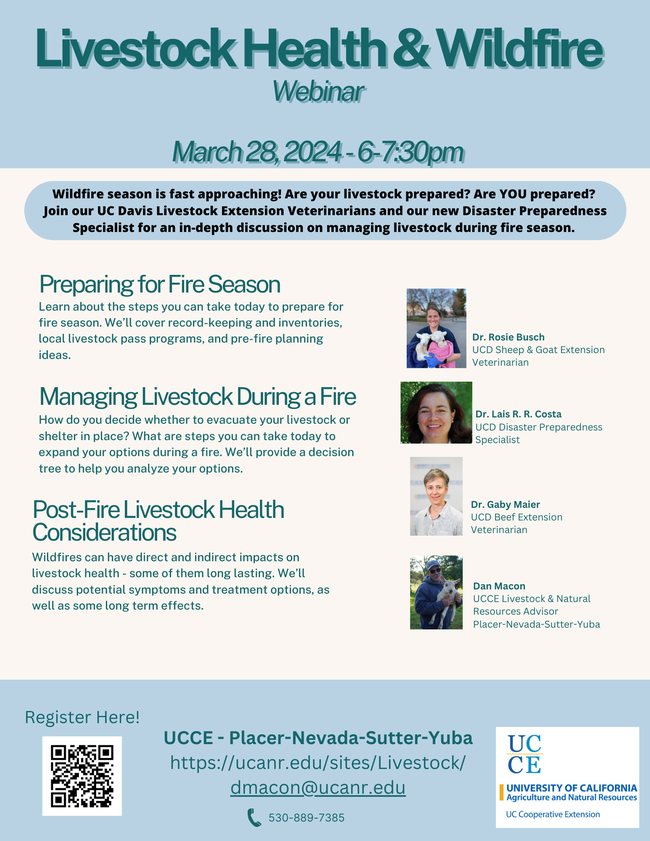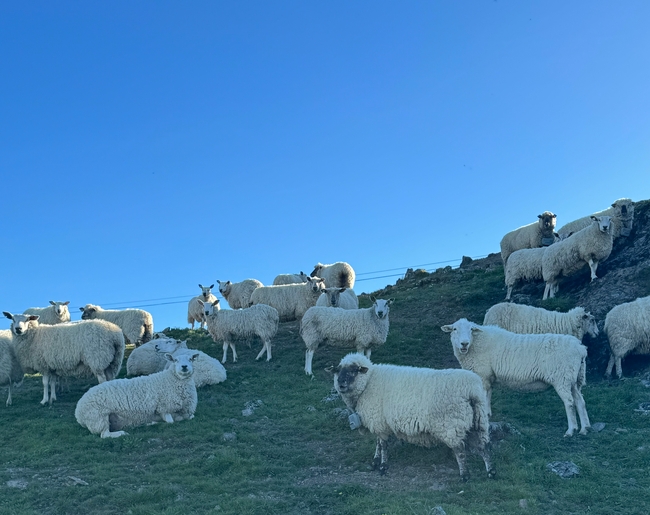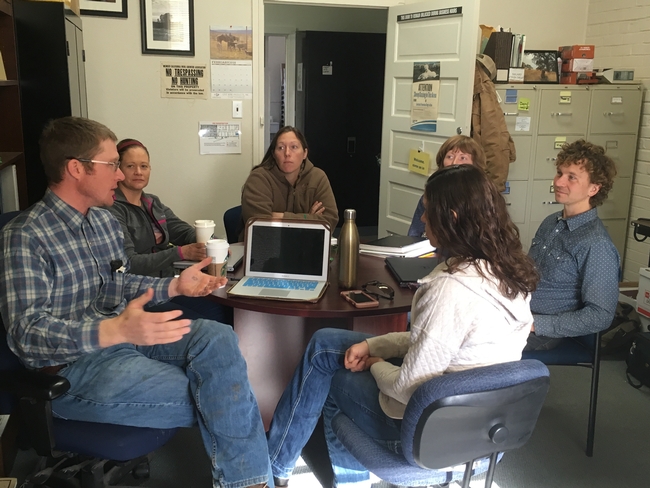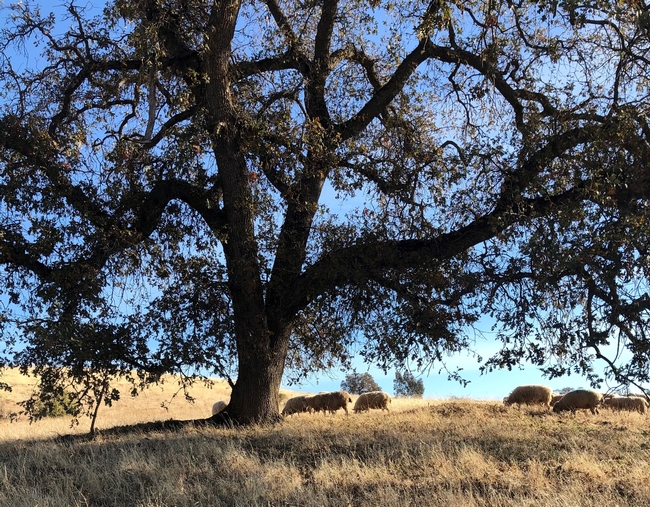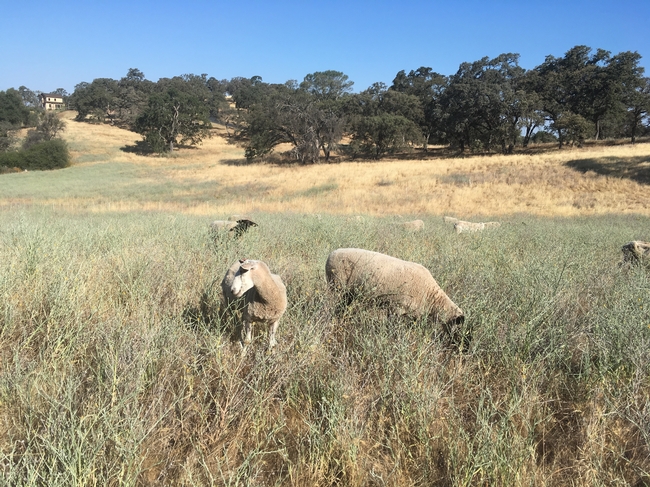- (Public Value) UCANR: Promoting economic prosperity in California
- Author: Daniel K Macon
We have several outstanding workshops coming up in the next three weeks! Contact me at dmacon@ucanr.edu or (530) 889-7385 for more information!
Livestock Health & Wildfire Webinar (Thursday, March 28 - 6:00pm-7:30pm) - Virtual: Join Extension Veterinarians Dr. Gaby Maier, Dr. Rosie Busch, and Dr. Lais Costa, along with UCCE livestock advisor Dan Macon, for a webinar focusing on livestock health and wildfire. We'll discuss preparations for fire season, decision-making during a wildfire, and managing livestock health after exposure to fire and smoke. This webinar is free, but you must register to receive the webinar link. Register at https://ucanr.edu/livestockhealth&wildfire.
Ag Technology Showcase (Thursday, April 11 - 4:00pm-6pm) - Auburn, CA: Join UCCE and other farmers and ranchers to look at new agricultural technology! We'll talk about (and demonstrate) virtual fence technology, electronic identification systems, on-farm weather stations, soil moisture monitors, drones, and other technology designed to improve efficiency and reduce costs. Cost: $10/person. Register at https://surveys.ucanr.edu/survey.cfm?surveynumber=42435.
- Author: Dan Macon
Register now for our upcoming September workshops!
Working Rangelands Wednesdays - Remote Sensing and Drought Forecast with Dr. Leslie Roche - September 7 - 6:00pm: The last in our series of Drought Solutions Webinars, this session will focus on efforts to develop forage production forecasting for annual rangelands, and will provide a look ahead at conditions this fall and winter. Register with this link! View previous sessions on our Working Rangelands Wednesdays YouTube Channel!
Crop Insurance / Pasture Range and Forage Insurance - September 13 - 6:30pm: We've invited a local crop insurance agent to walk us through the costs and coverage benefits of Specialty Crop and PRF Insurance. This workshop is FREE! Register here! This workshop will be held at the UCCE office in Auburn.
Beginning Farming Academy - September 30 - October 1: This 2-day intensive workshop provides an introduction to starting a commercial farming or ranching! We'll cover the basics of market-driven farming and ranching, provide you with economic analysis tools, and wrap up with an action plan for jump-starting your enterprise! The cost for the academy is $80 (to cover meals). Apply online.
- Author: Dan Macon
When we finally received a more than two inches of rain in mid-November, I was relieved that we would finally have germination on our foothill rangelands - better late than never! Today, after two weeks of sunshine, I am indeed seeing a little green coming up through last year's dry forage. But the forecast isn't promising - as of this morning (November 30), we have no rain in our forecast here in Auburn for the next two weeks. The combination of dry weather, short days, and colder (for here, at least) temperatures indicates that we won't likely grow much grass during the month of December.
Drought planning begins with proactive strategies - a conservative stocking rate, for example, or a production calendar designed to match periods of high forage demand with rapid forage growth. One of the most important proactive strategies in our small-scale sheep operation is grazing planning. Over the years, we've trained our eyes to estimate the amount of forage we have available - measured in sheep days per acre. While our estimates are not 100 percent accurate all of the time, the simple act of looking ahead and estimating the quantity and quality of standing forage gives us a better idea of when we might need to adjust our plans.
The second element of our planning process is the idea of key dates. For me, establishing a date by which we need to make a decision forces us to actually make the decision. During the 2013-2014 drought, Glenn Nader (who preceded me as UCCE livestock and natural resources advisor in Sutter and Yuba Counties) said, "The only way you're gonna survive a drought is to make decisions." This advice, obviously, has stayed with me - indecision prolongs the pain (economic and otherwise) of drought. In our operation, we look at forage conditions, weather forecasts, and our production calendar when establishing a key date. For example, our ewes will enter the last trimester of gestation in early January. At this point, their nutritional demand will begin ramping up significantly as they approach their lambing dates. While we've saved enough dry forage to get by for the next 5-6 weeks (which we can utilize by supplementing the ewes' protein intake), late gestation will require a different strategy. A key date also requires us to think about a condition that must be met for a decision to be triggered. This December, that condition is rainfall. If we haven't received an inch of rain by December 31, and if there is no rain in the 2-week forecast on that date, we'll need to make a decision.
This brings us to the last element of our drought plan - what are our options if we're still dry on New Year's Eve? For me, these reactive strategies are far less palatable - they cost us money (as in more expenses, less revenue, or both). Here are the options that are currently on the table:
- Purchase enough hay to get the ewes through late gestation and into the beginning of lambing season.
- Look for byproduct or other alternative protein and energy sources to feed the ewes.
- Sell older ewes to reduce forage demand.
- Sell replacement ewe lambs to reduce forage demand.
- Allow body condition to decline until the forage begins to grow (which may reduce lamb survival and future reproductive success).
- Find additional rangeland pasture to graze (this would still require some supplemental nutrition).
Over the next several weeks, we'll brainstorm additional options. We'll work through the economic ramifications of each of these options. We may choose a combination - perhaps we'd sell a few sheep and purchase hay to sustain the rest of the flock. The point here is that we've given ourselves a deadline for taking action, and we'll work through the numbers associated with each decision.
In the meantime, we'll keeping hoping for rain....
- Author: Dan Macon
October 2020 Beef Production and Targeted Grazing Webinars Now Available on YouTube!
Thank you to everyone who was able to join in one or more of our Beef Cattle and Targeted Grazing webinars during the month of October! We had great discussions on everything from managing parasites in cattle to bidding a targeted grazing job to managing pastures! I especially want to thank the Tahoe Cattlemen's Association for co-sponsoring the four cattle production sessions!
If you missed any of these webinars, or if you'd simply like to go back and review what you learned, I've loaded the videos of each session onto my YouTube channel! You can simply click the links below to watch the webinars!
An Introduction to Targeted Grazing (October 6) – learn the basics about managing targeted grazing for fuel load reduction and weed management.
Cattle Health with Dr. Gaby Maier and Dr. Becky Childers (October 15) – this webinar covers managing internal and external parasites, developing a vet-client-patient relationship, and how NOT to get fired by your veterinarian!
Beef Business Basics with Judd Tripp and JC Baser (October 20) – learn the basics of how to analyze your livestock business, and learn from the experiences of veteran Placer County ranchers.
Grazing Management Basics with Greg Lawley and Joe Fischer (October 22) – foothill ranchers discuss the art and science of managed grazing on rangeland and irrigated pasture.
The Business of Targeted Grazing with Bianca Soares (October 27) – learn about the business of targeted grazing, complete with tools for analyzing your own economic viability. The second half of this webinar features a question-and-answer session with an established targeted grazing contractor.
Beef Cattle Nutrition with Dr. Pedro Carvalho (October 29) – UC Davis/UCCE Feedlot Management Specialist Dr. Pedro Carvalho provides a basic overview of beef cattle nutrition in this final webinar.
And be sure to check out my Sheep Stuff Ewe Should Knowpodcast with fellow shepherd Ryan Mahoney – available on Spotify and Apple Podcasts! While our focus is on sheep, we cover topics of interest to most livestock producers!
If you have any questions, or ideas about future webinar or workshop topics, you can always contact me at dmacon@ucanr.edu or at (530) 889-7385.
- Author: Dan Macon
Be sure to check out our upcoming webinars on cattle production and targeted grazing - we have a great line-up of speakers and topics!
Tuesday, October 6 (6pm) - Introduction to Targeted Grazing
This webinar will provide an overview of targeted grazing, including grazing management, picking the right grazer for the job, livestock management, and customer relations. Cost: $10. Click here to register!
Thursday, October 15 (6pm) - Cattle Health – From Parasite Management to Vaccination Programs
With Dr. Gaby Maier (UCD School of Veterinary Medicine Beef Extension Specialist) and Dr. Becky Childers (Large Animal Veterinarian). Learn about controlling external and internal parasites, developing a vaccination program for your herd, and the importance of establishing a working relationship with your veterinarian. FREE! Sponsored by Tahoe Cattlemen's Association. Click here to register!
Tuesday, October 20 (6pm) - Beef Business Basics
With Dan Macon, UC Cooperative Extension; Judd Tripp, Placer County Rancher; and JC Baser, Placer County Rancher. This webinar will focus on basic economic analysis for new and existing ranching businesses. Our rancher panel will share their experiences operating successful foothill ranching enterprises. FREE! Sponsored by Tahoe Cattlemen's Association. Click here to register!
Thursday, October 22 (6pm) - The Basics of Grazing Management
With Dan Macon, UC Cooperative Extension; Greg Lawley, Placer County Rancher; Joe Fischer, Placer/Nevada County Rancher. Well-managed grazing can improve pasture productivity and cattle health. Learn the basics of grazing management and hear from ranchers who use these practices every day. FREE! Sponsored by Tahoe Cattlemen's Association. Click here to register!
Tuesday, October 27 (6pm) - The Business of Targeted Grazing
Join Dan Macon and a panel of targeted grazing contractors to learn about the ins and outs of building a targeted grazing business. Cost: $10. Click here to register!
Thursday, October 29 (6pm) - Beef Cattle Nutrition
With Dr. Pedro Carvalho, UC Davis Feedlot Management Extension Specialist. Learn basic information about beef cattle nutrition, from grazing to ration formulation. FREE! Sponsored by Tahoe Cattlemen's Association. Click here to register!
Once you've registered for each webinar, you'll receive a Zoom link that will allow you to participate. We'll also post videos of each webinar on the Ranching in the Sierra Foothills YouTube Channel.


